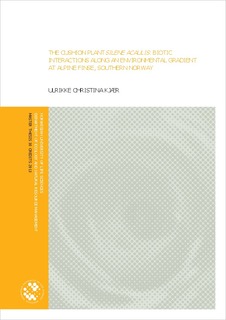| dc.description.abstract | Plants interact with each other in many ways. Competition for resources and space is well
documented among a wide variety of plants. Positive interactions, or facilitation, may also be
important for plant survival, especially in physically harsh environments such as alpine
regions. Silene acaulis and other cushion plants, which are common in the alpine, have been
found to facilitate species richness in the most stressful parts of elevation gradients. To my
knowledge, nobody has previously examined biotic interactions in cushion plants along
successional gradients.
I have studied the effect of S. acaulis on the diversity of vascular species, bryophytes, and
lichens, as well as on the fertility of vascular species and the growth of Bistorta vivipara,
along a successional gradient at alpine Finse, southern Norway. The gradient was situated in
the glacier foreland of Midtdalsbreen, where physical conditions gradually changed from very
harsh near the glacier to more benign further away.
I found that S. acaulis facilitated the performance of B. vivipara in the harshest parts of the
gradient. B. vivipara had longer and wider leaves, as well as longer leaf stalk, when growing
inside cushions of S. acaulis near the glacier. In the other end of the transect no facilitation
was found between S. acaulis and B. vivipara. Here, leaves of B. vivipara tended to be wider
outside than inside cushions of S. acaulis, possibly indicating competition between the two.
Species richness showed a weak facilitation from S. acaulis. Four species were only found
inside cushions, all with low observed numbers of individuals. No facilitation was found
when comparing number of species in cushion plots to their paired control plots.
Silene acaulis facilitates the performance of single species under harsh environmental
conditions, while only weak interactions between the cushion plant and species richness were
found at Finse. Previous studies have documented strong facilitation of species richness by S.
acaulis in similar environments. For a better understanding of plant interactions in
environmental gradients (and especially succession gradients), more research is needed. | no_NO |
